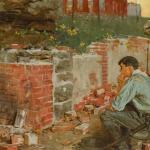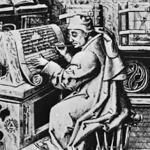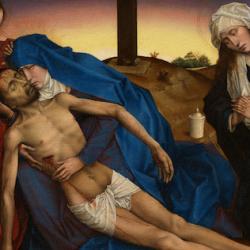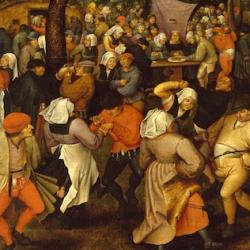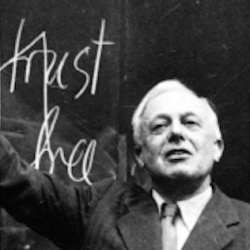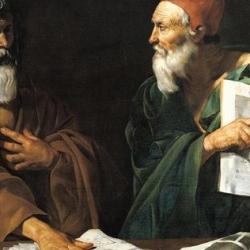IV. Cross of Reality
Christianity’s history is the story of the cross’s penetration into human experience and society. New epochs are formed when the cross begins to mark a new “sphere of our minds or bodies” (CF, p.165). In the new era that Rosenstock-Huessy saw coming, the cross needed to penetrate into social life.
In preparation for this new epoch, Rosenstock-Huessy thought, it is necessary to reformulate Christianity’s dogmas about the cross, translating it into “non-ecclesiastical, post-theological language” in an effort to show the pervasiveness of crucifixion. The “Cross of Reality” is a deliberate bid to formulate something like Bonhoeffer’s religionless Christianity.
Rosenstock-Huessy uses the Cross of Reality to describe the suffering at the center of human experience, and the unsystematic and unsystematizable complexity of life. While philosophers and scientists, metaphysicians and physicists, might describe the world as a system, actual reality and actual lived human life is a “perpetual suffering and wrestling with conflicting forces, paradoxes, contradictions within and without.” Life stretches us in opposite directions, tears and rends us, yet through this tearing makes us new (CF, p. 166).
Specifically, human beings are stretched out on two axes. The horizontal axis is a temporal one, stretching between past and the future. The vertical axis is spatial, as we are stretched out between “inner” and “outer.”
Time is not, as mathematics depicts it, a straight line, since a line does not distinguish qualitatively between past and future and cannot capture the multiform shape of human time. Time is an undifferentiated line for animals, which know “no future but only perfect and imperfect tenses, only processes that have ended or processes still going on at any given moment” (CF, p. 166).
For humans, a timeline turns time into space. This confuses things that should be kept distinct, since our experience of time differs radically from our experience of space. Space is experienced “as a whole.” We see a whole mountain range, a whole starry sky, a million man march on the Mall all at an instant.
Time, by contrast, comes to us as moments, fragments, as “a phantom moment or as innumerable phantom moments.” Time becomes organized and packaged into hours, days, years, epochs only “because we say so.” Times exist because “they are history-made units built by our faith, out of innumerable moments” (CF, p. 167). Time experienced this way is never uniformly one time: “Nobody lives in one time” (CF, p. 167). The past and future always inhabit the present, and so human beings are always being pulled backward by the obligations imposed by the past and striving forward by the hopes seducing us from the future.
The spatial axis of the Cross of Reality is the axis that stretches us between “inner” and “outer.” Individually, we all have an “inside” bounded by our skin, and a world outside us. (Rosenstock-Huessy would have us note, though, that the boundary of skin is permeable; we have pores and various orifices through which the world enters us and things from inside are poured out into the world.)
Corporately too, each community constitutes itself by setting a boundary between “insiders” and “outsiders.” The social body too has its skin, and must protect itself against infection from outside (CF, p. 168).
We hang at the center of this cross, nailed and pulled in all four directions at once: “man’s life, social as well as individual, is lived at a crossroads between four ‘fronts’: backward toward the past, forward into the future, inward among ourselves, our feelings wishes and dreams, and outward against what we must fight or exploit or come to terms with or ignore.”
This is a painful position, often agonizing, and so we are tempted to relieve the tension by embracing only one of the four points of this compass. But the goal of life is not “adjustment,” as modern psychology might suggest; the goal is integrating the demands of each, all of which are legitimate demands (CF, p. 169). Rosenstock-Huessy points out that “it is obviously fatal to fail on any front—to lose the past, to miss
the future, to lack inner peace or outer efficiency.” If we rush forward without acknowledging the past, “acquired qualities of character and civilization would vanish,” but if we dwell in the past “we cease to have a future” (CF, p. 168). Integrating these demands is never easy, and we never fully achieve integration. Life is mobile. We are tossed here and there, shocked and thrown by the demands thrust on us from the outside, surprised by the unanticipated future. While we strive for integration, we cannot be at every point of the cross equally at the same time.
Life is thus “a perpetual decision.” We must determine when to perpetuate or revive what is past, and when to let the past die and lie quietly buried. We must recognize the difference between those “within” our circle to whom we speak and the things “without” about which we speak. To live is to dance, as we strive to preserve “a delicate mobile balance between forward and backward, inward and outward” (CF, p. 168).
Elsewhere, Rosenstock-Huessy treats the four points of the cross as four dimensions or aspects of time. Time has “four leanings, four inclinations”—lyrical, analytical, dramatic, and epochal. Lyrical time is “inner” time, when, singing or watching a sunset or absorbing ourselves in a book, we “are lost on the inside.” A
nalytical time occurs when attention is focused outward. Lyrical time focuses on the mood of time and ignores time’s movement, but analytical time ignores mood and is very conscious of the ticking clock. A factory manager attempting to organize his workers’ time efficiently is in analytical time; a basketball player who keeps glancing at the shot clock is also experiencing time analytically. Dramatic time is oriented to the future. It marks a break in time, with the dramatic moment the breach between a before and an after.
Dramatic time makes new time and creates future. Epochal time, finally, is oriented to the past. We experience time epochally when we focus on the repetitions and routines that persist from the past into the present. A sunset can be experienced as a moment of epochal time (it happens every evening) or as lyrical time (when we lose ourselves in the unique beauty of this sunset). Epochal time, like lyrical time, seems to stand still, not because we are lost inside but because nothing seems to change.
Like individuals, societies are also on the Cross, and thus always threatened by internal division. Different social groups and professions stand at different points of the compass. Lawyers and teachers pull back as politicians push forward; poets rhapsodize on traditional landscapes while engineers cross the scenery with new bridges.
Like individuals, societies are always in danger of lurching in one direction or another, and strive to integrate the demands of the Cross by a division of labor, distributing responsibilities for past and future, preservation of the inside and mission to the outside, among various subgroups or individuals: “teaching, ceremony and ritual preserve our continuity with the past, and teachers, priests and lawyers serve on this front for all of us.” The “inside” is built up by “playing, singing, talking together, sharing our moods and aspirations, and on this inner front poets, artists, and musicians are typical representatives.”
On the outer front, we aim to “control natural forces” and manipulate them “for our ends in farming, industry and war,” aided by “scientists, engineers and soldiers.” Finally, future is kept alive by “religious and political leaders, prophets and statesmen,” whose task is to initiate change and pull us into the future (CF, p. 169). Integration of these social demands requires that “specialists” make room for those leaning in the other directions, recognizing the legitimate claims of others without abandoning their own legitimate claims.
Societies move through the tensions of the cross and are made new only through love, forbearance, and mutual honoring and recognition of differing gifts.
Rosenstock-Huessy’s main argument in favor of the Cross is “the fertility of its applications” (CF, p. 168, fn 3), and to him the Cross is as fertile as weeds. It provides him with a ready-made inoculation against reductionisms of all sorts. Cruciformity implies the “multiformity” of man, society, history, human life.
As an example of reductionism, Rosenstock-Huessy notes the work of Josiah Royce. While commending Royce’s philosophy on loyalty, he criticizes the attempt to reduce every virtue to an expression of loyalty. Loyalty is oriented toward the past, and if loyalty is an absolute imperative, there is no place for the obligation to break away in a new direction. Loyalty must coexist with love, which stretches the person toward the future: “to say that a man leaves father and mother and cleaves to the wife of his choice out of loyalty simply does not make sense” (CF, p. 170).
Scientific modernity in general is reductive in another direction, obsessed with the “outward front” as it treats everything as “something merely to classify, experiment with, describe, control.” This is an essential pole of human existence, but you cannot treat your wife like that (CF, p. 170). Intellectuals are prone toward reductionism as well.
Thought, Rosenstock-Huessy argues, is “provoked by our ends,” and particularly by the end of death. But thinkers would not have time to think about death and the future unless other members of the society devoting themselves to other tasks, guarding other poles of the cross of reality. How can a philosopher dream his dream of reason unless he can sleep at night, unless he can be confident that the Gestapo is not going to beat his door down at any moment (CF, p. 171)?
The Cross of Reality also serves as an analysis of the social death that “lurks in wait for us on every front, if we fail.” Death can occur when any one of the four poles is forgotten: “Decadence, for instance, means being unable to reach the future, in body, mind or soul” (CF, p. 173). Decadence is a failure to reach future.
Revolution, by contrast, is a failure in the direction of the past, anarchy a failure to build inner unity, and war a failure to engage peaceably with the external world. No community can be purely self-contained, and will collapse if it does not have some kind of contact with a larger world outside.
Intellectually, the Cross of Reality transcends the division between philosophy and theology that came into existence in the middle ages. Philosophy has worked in a spatial framework, emphasizing “the world of space or the knowing mind and a corresponding logic of timeless abstractions.” For philosophy, time appeared “foreshortened,” and in the sciences to which philosophy gave birth the same spatialization is evident.
Theology, by contrast, is interested in history—Adam, Abel, Abraham, Jesus, and the Judgment. The “division of labor” between philosophy and theology was a “working compromise” between Christianity and Greek philosophy, but this compromise is no longer viable. The Cross of Reality attempts to “overcome the division and fuse space-thinkers and time-speakers into one new profession” that is no longer exactly philosophy nor exactly theology. This would “accomplish the penetration of the Cross into the last stronghold of paganism within our own traditions,” the stronghold of philosophy and science (CF, pp. 173–4).
The Cross even enables Rosenstock-Huessy to encompass transcend the boundary between Christianity and other religions in a single framework. As a Cross of Reality, the cross is not an exclusively Christian symbol: “the great civilizations of the Orient, China and India” are “under the Cross too.”
To illustrate, he integrates Buddha, Laotse, Abraham, and Jesus into a single unified, cruciform tension (CF, pp. 177–190): “The founders have mastered each direction of the Cross of Reality by living the pure eye, the silent voice, the humble heart, and the fire of new love. Nirvana, Tao, loyalty to loyalty, and rebirth are permanent standards for the full life of man” (CF, pp. 190–1).
There are hints too that the Cross of Reality is a developmental model. We are plopped into the midst of a history with a past that is not of our choosing, addressed as “thou”; at adolescence we develop the inner self-consciousness of “I,” but we move to a future when we form the “we” of marriage. When the story of our lives is complete, we may be examined as an “object,” from the outside.
A name, he argues, places us at the crossroads of the Cross of reality. Drawn from the past, it calls us to continuity with our heritage; a name gives us a model to strive to achieve in the future. A name identifies us with the inside of the community, and our name is the mark of our identity as we cross the boundary to the outside of the community.
The various moods and types of grammar also correspond to the cross in various ways. The imperative “you” is a voice from the past; the narrative “we” takes us together into the future; the subjective “I” is an expression of the inner man; and outside we deal with various “its.” If any of these forms of speech fails, human life is impoverished and human society cannot function. If any of these forms of speech colonizes beyond its proper sphere, we again face a personal and social crisis. We cannot deal with our children or spouse as “its.”
V. Conclusion
For Rosenstock-Huessy, the cross of Jesus reveals the meaning of the general Cross of Reality, but there are not two crosses, rather ultimately one. Every human being is stretched out on the Cross of Reality, between the obligations imposed by the past and the desire for the future. Every decent child wants to honor his parents, and yet refuses to relive the life of his parents. Pulled between parental obligations and future hopes, he lives in anguish. Every thoughtful human being dreams of a different world, but finds the world reluctant to comply with his dreams. And thus he is stretched between inner and outer.
This, as I say, is a universal experience. What Jesus reveals is that abundant life is found precisely in being stretched between past and future. Abundant life is not found in an enclave of the conservative past, or in the exuberance of a titillating present, or in a cell boiling with a revolutionary future. Abundant life is not found in retreat to contemplation or in self-forgetting activism.
Abundant life is found when, in faith and hope, we submit to being torn between past and future, inside and outside, and see it as a gateway to renewal. Abundant life on the Cross of Reality comes through the cross of Jesus, when, torn by past and future, by inside and outside, we hope against hope for transfiguration.

